This FAQ text is copyright dslreports.com
Reproduction of all or part only with our permission..
This FAQ is edited by: Pinan  , redxii , redxii 
It was last modified on 2014-09-22 15:14:27
1. DRTCPDRTCP: How do I use it and what are all these settings?DRTCP works with Win95/98/98se/ME/2K/XP. This is not meant to be a Tylenol inspiring, technical documentation, but merely a basic guide to understanding how you can best use this great tool (surprise at end). DRTCP is not a patch, but a shortcut (GUI interface) into your registry. It does not enter anything by itself. You can down-load DRTCP here TCP Receive Window: This is where you set RWIN (RcvWindow). RWIN is the single most important tweak. Raising Rwin from default (8760 for Win95/98/98SE/NT and 17520 for WinME/2K/XP), can greatly improve download speeds. Why? Here is my kindergarten analogy: Default RWIN for broadband, is like having a tiny straw in a thick milk shake, only so much can get through the straw (line), so fast. By putting a larger straw (higher RWIN) in that same thick shake, you allow more shake (data) to come through faster, to a point that is. After which, there is no more improvement, and shake (data) can start spilling all over (packet loss). So the key is, to find an RWIN that fits your line just right. This is blank before changing from default. The formula for finding your "ideal" RWIN, is to take your latency (average ping time in ms x 1.5), multiply that by your advertised (download) speed, and divide that by 8.
Note: If setting RWIN below 8192, try using even multiples of MSS.
Windows Scaling: 65535 is the highest RWIN you can use without Windows Scaling being turned on. So simply put, Scaling is needed to enter any number higher than 65535. However, you must also have the updated vtcp.386 patch (WinME/2K/XP does not need a patch). Relax though, most users do not need to go higher than 65535. Windows Scaling "Defaults" to off (same as No).
Time Stamping: The need for this seems to be in question, at least with RWIN under 65535. If you have a line where latency varies a lot, or a "long fat pipe" (for example, pure satellite connection), then Time stamping should be beneficial, so experiment with it. Time Stamping "Defaults" to off (same as No).
Selective Acks: This improves throughput (speed) on lines that tend to lose packets, by re-transmitting only packets that were lost, if any. "Defaults" to on (same as Yes) in Win98/98SE/ME/2K/XP and is N/A in Win95/NT.
Path MTU Discovery: This automatically sets your MTU (maximum transmission unit) to what type of line you have (dial-up (576), broadband 1492-1500). This is the size of packets that you can receive. The highest MTU that one can have is 1500. For users with PPPoE connection software, 1492 and lower. Without PPPoE, it should default to 1500. "Defaults" to on (same as Yes) in Win98/98SE/ME/2K/XP/NT, and is N/A in Win95.
Black Hole Detection: This discovers routers on the WEB that cause MTU Discovery to work sub-optimally. "Defaults" to off (same as No) in Win95/98/98SE/ME/2K/XP.
Max. Duplicate ACKs: This allows for faster re-transmission of packets (information), when packet loss is encountered. "Defaults" to blank, where blank stands for 3 in Win98/98SE/ME, 2 in WinNT/2K/XP, and is N/A in Win95.
TTL: Time To Live is the amount of hops (servers) that a transmission of packets will take before all packets are lost. If you were receiving packets from 20 hops away, and TTL was set to 19 or less, all packets would be lost before they reach you. Not a speed tweak. "Defaults" to blank, where blank stands for 32 in Win95, 128 in Win98/98SE/ME/2K/XP.
Adapter settings: This is where you set your MTU. Use the drop-down menu to find your NIC (Ethernet card). If you do not know which adapter you should set, please ask. Do not set them all the same. (Note: If your MTU is 1500 by default, it will be blank in DRTCP. Also: Only physical NIC's supported for XP, no dial-up adapters.
Note: DRTCP defaults to showing the dial-up adapter. This has nothing to do with the other settings. It does not matter which adapter is visible when setting anything except MTU. Also: Upon reboot the dialup adapter will be showing, regardless of which adapters MTU was set.
ICS Settings: Internet MTU is set when Internet Connection Sharing (a Microsoft program) is enabled and being used on your PC. This is where 2 or more PCs share the same Internet connection, though only one can surf at a time. ICS MTU should match that of the PC. This is grayed out if ICS is not being used (not ready for Win2K/XP).
Also: By right clicking on the logo and choosing "About", you will find information about the version of Windows you use.
Great, so what should you set all of these to? Most users can leave all of them at Default (surprise!) except for RWIN, as this has been determined to be best, most of the time, thus being "Default". After making any changes, click Save, then Exit, then reboot (restart) your PC. Use the Tab button on your keyboard to move about DRTCP. If you do not reboot, the settings will not "take".
DRTCP recommended by Cisco
~~~~~~~~~~~~~~~~~~~~~~
Uninstall: Since DRTCP is a GUI interface (never mind), it is not installed. Therefore there is no uninstall. Right click on DRTCP and choose Delete, if you wish to.
To simply set your registry back to it's default settings, set everything to "Default" or blank (cleared of value), click Save, and reboot. Done.
RWIN: How do I raise/lower mine?How do I restore default settings?In DrTCP, blank every field. Save, exit and reboot.
What Operating systems are supported by DrTCP?The Following Windows OS's are supported by the newest version of DRTCP021.zip:
Win95/Win95b/Win98/Win98SE/WinME/WinNT 4.0/Win2k/*WinXP
*Some WinXP users have have not been able to use DRTCP effectively.
*There are no plans to make DRTCP work with Vista or Windows7*
Why are some selections grayed out?If a selection box is grayed out, it's likely that particular selection does not apply to your OS's setup (NT/some Win95). If you have questions or are unsure, ask in the Tools or Tweaks forum for further details.
Win95 has an update patch that will enable these. The patch is called "WinSock2" and is available in Tweaks "Links."
Satellite Connections: Adjustments won't take!At this time, the tweak tester does not work for satellite connections. Since these systems use Network Address Translation (NAT), the IP address used by the tweak tester to find your computer's TCP settings is actually not reading your computer at all. It is reading the computer at the Network Operations Center that is providing the NAT services. This doesn't mean that the changes you made with DrTcp didn't take. It just means the tweak tester cannot detect the changes.
TTL: What should it be set to?As TTL is merely a hop count, not a speed setting. Windows default of 128 is just fine. No further adjustment is needed.
Only in Win95 should it be raised from 32 (default).
I have duplicate adapter entries in DrTcp. What can I do?1. Rename your current connection (Start/Settings/Control Panel/Network Connection, or Right click on My Network Places on your desktop and choose Properties) to a satisfactory NEW name (e.g. myadapter). 2. Start REGEDIT.EXE and using Edit/Find, search for the new name you entered in step #1. (You will find something like this: [HKEY_LOCAL_MACHINE\SYSTEM\ControlSet001\Control\Network\...])  3. Clear all keys only in the same level except the one that has the same new name you renamed in step #1. 4. Search again (F3 key) and repeat step #3 above until you reach the end of register. (You will find something like this: [HKEY_LOCAL_MACHINE\SYSTEM\ControlSet002\Control\Network\...]) 5. Close REGEDIT.EXE. 6. Reboot your computer. Warning: Editing your registry is risky business. Use the above procedure with caution. How do I change back to default settings?In windows xp, just delete the value in drtcp, save and restart.
2. General QuestionsStalls and freezesIf you are getting stalls when using your PC Before your new ADSL line has been activated, your new internal ADSL card could be attempting to talk to the network (which is not yet configured for you), and while it does this, your PC may freeze. The solution is to remove the drivers for the card and/or the card itself until the ADSL line is activated by the Telco, then re-install from scratch. If your PC is freezing regularly, and you are on PPPoE, your computer may be looking around for a DHCP server that does not exist. Check the following: (windows) • Open control panel, open Network •For Windows 2000/XP, instead, do -> Start -> Settings -> Network and Dial-Up Connections, and then go into the Properties for your Local Area Connection • Look for the first entry in the scroll box marked TCP/IP that is associated with a hardware ethernet card (ignore dialup, AOL and VPN type bindings). • Select it and press properties• Select IP address from the tab • Is Obtain IP address automatically checked? If so, change that to Define IP address and enter 192.168.1.10 and 255.255.255.0 into IP address and subnet mask fields respectively. This assignment of a harmless local IP address to the TCP/IP settings bound (connected) to your network adaptor will stop the in-built DHCP services from waking up every 10 minutes to look for a DHCP server so that it can "fill in the blanks." If you are using Win98SE, also use this update: Windows 98 Second Edition Problems with NDIS Intermediate Drivers.
Also see this thread: Internet freezes momentarily while surfing.
PPPoE & PPPoA: What do these stand for?PPPoE stands for Point-to-Point Protocol over Ethernet.
PPPoA stands for Point-to-Point Protocol over ATM (Asynchronous Transfer Mode)
Macintosh TweaksMacintosh TCP/IP (Tweak) tuning program is hereFollow this link to the Macintosh FAQ on this topic. Enternet: Where can I find information about it?There is a good Enternet FAQs site [site down for now].
RASPPPoE: Where can I get it?You can get it free from their website here. WinPoet: Where can I find information about it?You can find information for WinPoet at the following sites: Windows client: WinPoetMac client: MacPoetPing: Can it be lowered/adjusted?Simply stated, NO.
Ping is latency on the Net, and not your computer, therefore it can not be lowered. Latency changes every second on the Net, with the pulse of its many users.
Lowering ping by adjusting RWIN is simply an urban legend and not true, as RWIN and ping use two totally different protocols.
If you lower MTU, the latency of your packets should improve, though your download speed will decrease as well. Some gamers prefer this course of action, though.
A bad NIC, modem, etc may also be the cause of high ping. These must be replaced by the user.
Which PPPoE software do you have, you ask?Check this link for screen shots of the various types. What is Tweaking, and do I need to do it?Tweaking is a term used to denote improving one's system performance. Here in the Tweaks Forum, we strive to improve your download speeds (upload can not be adjusted) as much as possible, as well as to fix other TCP/IP (speed-related) problems that you might have.
The two things to focus on most are your RWIN (Receive Window) and MTU (Maximum Transmission Unit) settings. These two are truly about the only things that affect speed.
The Tweaks Forum prides itself in assisting users on a one-on-one basis, as opposed to simply telling you to download something (such as a "speed patch") to do it for you. Every user's line can be different, thus the tweak being different, too.
Where can I find info on tweaking a Linux system for broadband?Here is a good place to start. What does power-cycle my modem mean and how do I do it?A: Power-cycling your modem is similar to doing a warm boot of your computer. By power-cycling, you are essentially resetting it. Here is how to do it: 1) Turn the modem off (if no switch, simply unplug it) for 45-60 seconds and unplug it from your phone line. 2)Reconnect the phone line and turn the modem back on (or plug it back in), being sure that it is not near anything that emits EMI (see this FAQ 3078 for details), such as CPU, monitor, TV, speakers, lamps, radios, etc. But I have an internal modem. Can I power-cycle it? Yes. 1) Power down your computer. 2) Unplug the modem from the phone line. 3) Wait 45-60 seconds, reconnect phone line and reboot you computer. How do I stop connection from timing out on webpages?Sometimes, when you try to connect to a website, the connection attempt "times out" due to the slowness of response, and you get a "Could not connect to ... "
If you frequently encounter this problem and wish to wait for the connection anyway, then here is the cure. It will apply to all sites, though you will still have the option of clicking the Stop button. THPC is too busy (!) to use this tweak, but testing confirms that it works.
1. First, backup the Registry.
2. Run RegEdit and navigate to:
HKEY_LOCAL_MACHINE\System\CurrentControlSet\Services\Class\Net
3. In the left pane, locate the 0000 Key (or 0001, 0002 or 0003) that represents your modem or NIC.
4. Under that Key, locate the Value name called "SLOWNET" (right pane).
5. Double click on SLOWNET and change "Value data = 01" (zero & one) to "00" (two zeros).
6. Close RegEdit and reboot.
Is there any way to tweak my Pocket PC PDA?Yes. This freeware utility will allow you to tweak your Pocket PC 2002's tcp/ip settings. 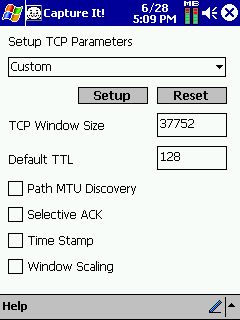 Tweaking: A Simple AnalogyDownloading and uploading files is like transferring a dirt pile from one location and placing it in another. The dirt pile is the IP (Internet Protocol). The place where you want to move the dirt pile is the other IP. The process of moving the dirt to the other location represents the TCP (Transmission Control Protocol). The wheelbarrow you will use to move the dirt is the MTU (Maximum Transmission Unit). The amount of dirt you put into the wheelbarrow is the RWIN (TCP Receive Window). If you put too much dirt into the wheelbarrow, it could be heavy, even spilling on the ground -- that's the Packet Loss. If you would place less dirt in the wheelbarrow, it will be easier to haul it and you can move faster; the only catch with this is that you will have to make a few more trips in order to complete the task. As you see, you have to find that medium with the loads of dirt to the round trips to each dirt pile.
How do I reset the TCP/IP stack in Windows XP?When viewing the list of components for a network interface, you may notice that the Uninstall button is disabled when Internet Protocol (TCP/IP) is selected. In Windows XP, the TCP/IP stack is considered a core component of the operating system; therefore, it is not possible to uninstall TCP/IP in Windows XP. In extreme cases, reinstalling the Internet Protocol stack may be the most appropriate solution. With the NetShell utility, you can now reset the TCP/IP stack back to a pristine state, the same state as when the operating system was installed. Learn how here: Microsoft Knowledge Base Article - 2993573. Becoming PingableHow do I become pingable with Zone Alarm?Bring up ZAP Control Panel. Click on "Security." Click on "Customize" on the Internet side. Put a tick mark in "Allow incoming ping(ICMP Echo)." Click on "Apply," "OK," and then close the program. This will allow you to be pingable without coming out of Stealth Mode entirely and can be used in Line Quality and Tweaks. Make sure you return to your previous settings when you do not need to be pingable. Zone Alarm Pro, version 4: Bring up ZAP Control Panel. Select "Firewall" on the left, then "Main" at the top. Click on the upper "Custom" button (Internet Zone Security). Put a tick mark in "Allow incoming ping (ICMP Echo)." Click on "Apply," "OK," and then close the program. This will allow you to be pingable without coming out of Stealth Mode entirely and can be used in Line Quality and Tweaks. Make sure you return to your previous settings when you do not need to be pingable. Version 4 tips courtesy of Basil2  Version 7 (Paid): 1) Bring up the control panel. 2) Select the custom button Internet Zone Security. 3) Click Allow incoming ping (ICMP Echo). ~~~~~~~~~ Also try this: Zone Alarm has two zones. Local Zone and Internet Zone. It is normal to set Local Zone security to medium or lower. You must then place our monitoring stations into the list of "local hosts". Please check this screenshot to see an example of the properties screen of Local Zone setup correctly to except our monitoring systems. Please note that the IP's in that screenshot are not the current IP's. The machines that (currently) do the monitoring are ny-monitor.dslreports.com sjc-monitor.dslreports.com dslreports-west2.speakeasy.net (64.81.79.40 AND 64.81.79.41) These hosts should be be added to your firewall if ICMP ping is being blocked. The IP addresses do change from time to time, so if you must enter IP address and not DNS name, then please do an NSLOOKUP or PING to make sure of the current IP address. Important: if you PADLOCK your zonealarm, no matter what, you are disconnected from the net. This will break monitoring. If you wish fulltime line monitoring, the PADLOCK function should not be used. How do I become pingable with WinXP firewall?1. Click Start and open Control Panel. If using the classic start menu, Control Panel is located in Settings. 2. If Control Panel is in Category View, open Network and Internet Connections and then Windows Firewall. If using Classic View, open Windows Firewall. -OR- Click Start, Run and run the following command: firewall.cpl 3. Go to the Advanced tab, under ICMP, click Settings.... 4. Place a check in Allow incoming echo request, then click OK twice. You will then be pingable. 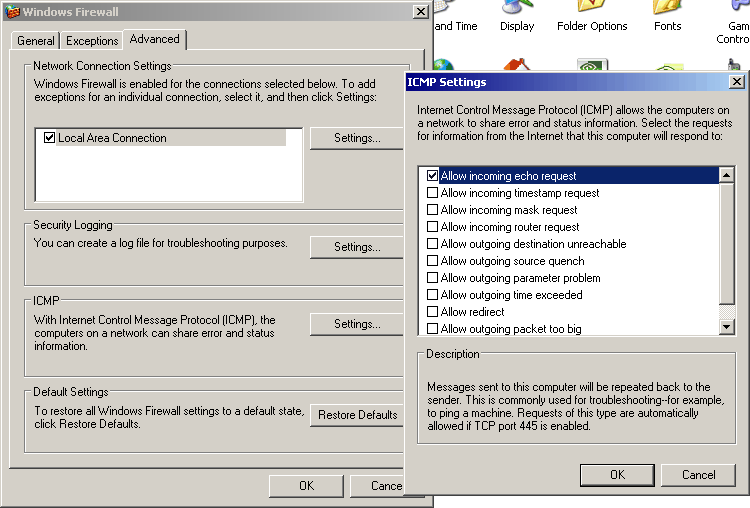 How do I become pingable with McAfee Firewall?Version 10.3
- On the McAfee SecurityCenter pane, click Internet & Network, then click Configure.
- On the Internet & Network Configuration pane, under Firewall protection is enabled, click Advanced.
- On the Security Level pane, under Security Settings, select Allow ICMP ping requests to allow detection of your computer on the network using ping requests.
If the firewall is set to Stealth security level, and you try to ping the computer from another computer in your network, the ping will fail. Both IPv4 and IPv6 block ICMP traffic when the firewall is set to Stealth mode, even if Allow ICMP Pings is enabled. ICMP requests are ignored as a way of protecting your computer on the network by keeping it hidden. To allow a computer to respond to ICMP pings you must lower the security settings. Raise the security level once testing is complete. How do I become pingable with Sygate Personal Firewall?Here are the directions: 1. Double click the Sygate tray icon 2. Tools > Advanced Rules > Add 3. In rule descriptions, type: BBR 4. Select "Allow Traffic," select your NIC (Network Interface Card) and select your screen saver mode. 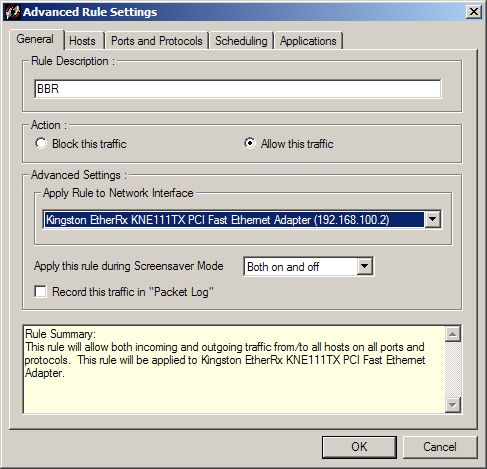 7. In the Hosts tab, select "IP Addresses" 8. Type in: 206.65.191.129,209.123.109.175,209.191.132.40,66.80.133.170,216.254.95.40 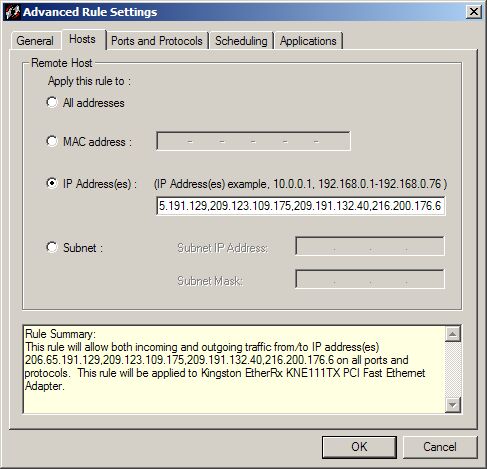 9. Hit Protocols and Ports tab 10. Check "Echo Reply - 0" and "Echo Request - 8" 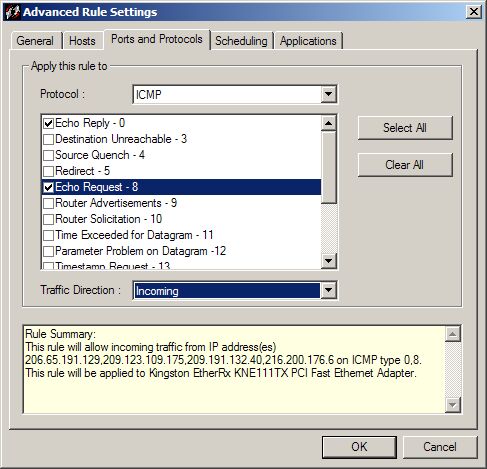 11.Under Traffic direction, select Both Directions. Click OK twice and close Sygate. You're done. How do I become pingable with Kerio/Tiny Personal Firewall?This works even with "Deny Unknown" used. Tested with Tiny and Kerio Personal firewall pre-3.x. 1) Open up the firewalls Administration area, then click Advanced...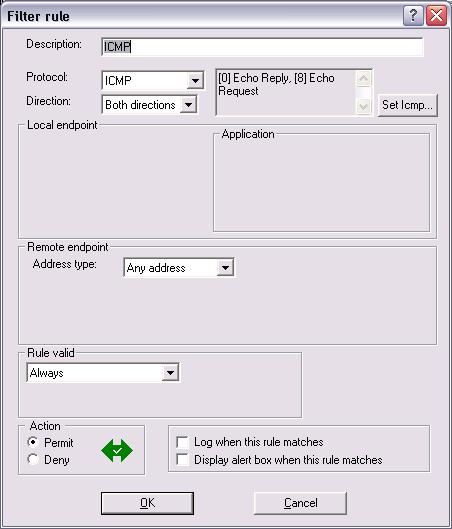 2) Click Add...Set everything to the following: DescriptionAnything you want it to be. ProtocolICMP. Click Set ICMP and choose [0] Echo Reply and [8] Echo Request. DirectionBoth directions. Remote EndpointAddress type: Any address ActionPermit. 3) Click OK, then Apply. You should now be pingable. How do I become pingable with Norton Personal Firewall?Here are the steps for NIS 2002: See below for 20031) Open the NIS/NPF Main Window 2) Click on Personal Firewall 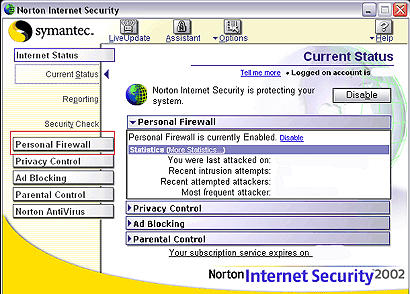 3) Click on Internet Access Control 4) Click on Configure 5) Click on System Wide Settings  6) Click on Add 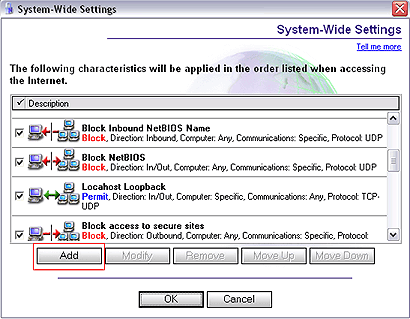 7) Select Permit 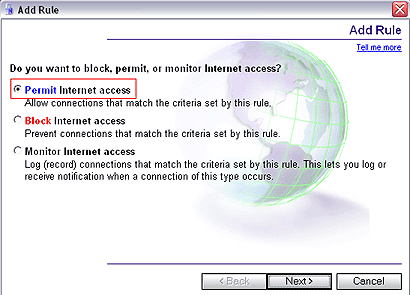 8) Click on Next 9) Select Connections to and from other computers 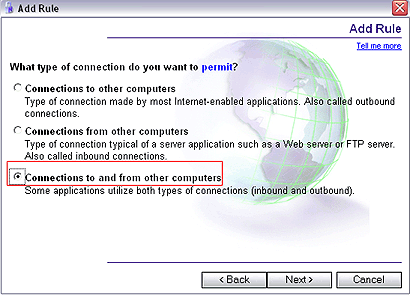 10) Select Only the computers and sites listed below 11) Click on Add 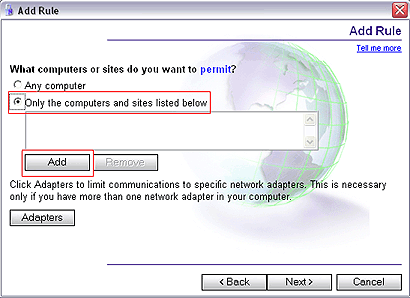 12) Select individually and type the following IP Addresses in the box spacing once between each 206.65.191.129 209.123.109.175 209.191.132.40 216.200.176.6 40.132.191.209 Note: Because of a bug in NIS/NPF, the IP address of some incoming ICMP requests are inverted. Therefore, NIS/NPF "sees" 209.191.132.40 as 40.132.191.209. This means that although 40.132.191.209 is not an IP address belonging to BBR, it must be included to be pingable. It is important to note that this is not a security risk. It simply means that your computer will respond to a request from 40.132.191.209. It is hoped that Symantec will correct this soon.13) Click OK 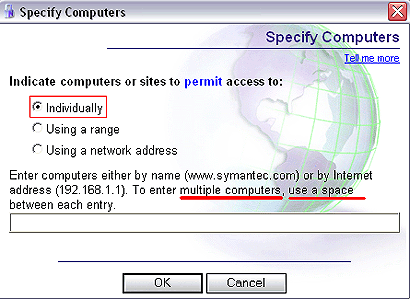 14) Click Next 15) Select ICMP 16) Select Only the types of communication or ports listed below 17) Click Add 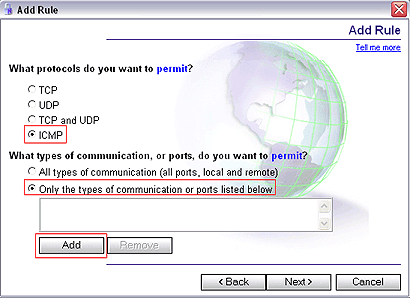 18) Select 0 echo Echo Reply and 8 echo-req Echo Request 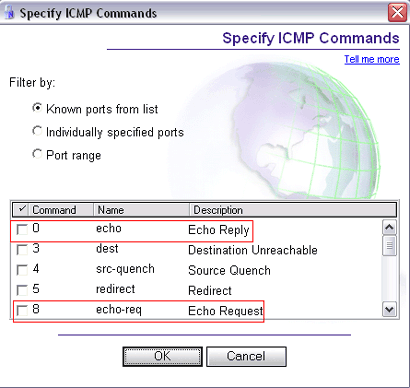 19) Click OK 20) Type a name such as "BBR Pingable" 21) Click OK 22) Close NIS/NPF Window 23) Reboot Note: This rule must be moved to the top of the System Rules, otherwise the default rules will override the DSLR rule. If you prefer not to be pingable by DSLR/BBR all of the time, you may de-select the rule that you just created by un-checking the box next to it in the System-wide Settings list. To become pingable for tweak tests, simply activate the rule before initiating the test, then de-active after. Here are the steps for NIS 2003: 1) Open the NIS/NPF 2003 Main Window 2) Click on Personal Firewall 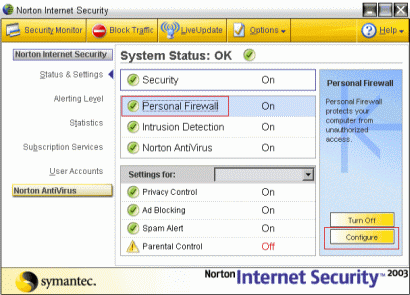
3) Click on Configure (enter password if requested) 4) Click on the Advanced Tab 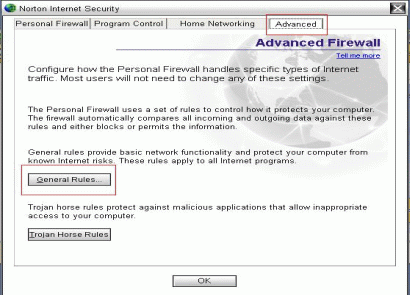
5) Click on the General Rules button 6) Continue with the above directions for NIS 2002 starting from number 6. --
Thanks to jazzman916 for the directions and screen shots. How do I become pingable with the Vista firewall?To edit local Group Policy settings for Windows Firewall with Advanced Security, use the Local Computer Policy snap-in. To open the local Computer Policy snap-in, type secpol at the command prompt. If the User Account Control dialog box appears, confirm that the action it displays is what you want, and then click Continue. Navigate to Computer Configuration\Windows Settings\Security Settings\Windows Firewall with Advanced Security to configure the Windows Firewall with Advanced Security policy
To enable ICMP Echo Request for ICMPv4 and ICMPv6.
1. In the Windows Firewall with Advanced Security snap-in, click Inbound Rules in the tree, and click New Rule in the Actions Pane.
2. Click Custom and click Next.
3. Click All programs and click Next.
4. For Protocol type, select ICMPv4.
5. Click Customize for Internet Control Message Protocol (ICMP) settings.
6. Click Echo Request, click OK, and then click Next.
7. Under Which local IP address does this rule match? and for Which remote IP address does this rule match click either Any IP address or These IP Addresses. If you click These IP addresses, specify the IP addresses and click Add, then click Next.
8. Click Allow the connection, and then click Next.
9. Under When does this rule apply?, click the active profile, any or all profiles (Domain, Private, Public) to which you want this rule to apply, and then click Next.
10. For Name type a name for this rule and for Description an optional description. Click Finish.
11. Repeat steps for ICMPv6, selecting ICMPv6 for Protocol Type instead of ICMPv4.
How do I become pingable with a router or hardware firewall?Due to varying & ever-changing manufacturers, models, and firmware, it is tedious to list instructions for every one of those. Refer to your router or hardware firewall documentation, either included with your router or hardware firewall and is also usually available in PDF format from the manufacturer's website.
4. MTUMTU: How high can/should mine be?MTU (Maximum Transmission Unit) will vary with connection type. Cable and non-PPPoE (Point to Point Protocol Over Ethernet) can use up to 1500.
PPPoE connections (WinPoet, RASPPPOE, Enternet, etc.) can only use up to 1492. However, WinPoet and Enternet MTU must be set by hand in the registry. Others may use DRTCP to set MTU.
Max MTU: How do I find mine?The MTU setting controls the maximum ethernet packet size your PC will send (you did know the internet works in packets, didn't you?). Why a limit? because although larger packets can be constructed and sent, Your ISP and Internet backbone routers and equipment will chop up (fragment) any larger than their limit, then these parts are re-assembled by the target equipment before reading. This fragmentation, and re-assembly is not optimal. MTU and Windows and DefaultsUnless otherwise set, windows defaults MTU to 1500, or a lower value of 576 for external networks. 1500 is ok unless you are running PPPoE, or want to use IPSec (Secure VPNs), or both, (it is then too big). 576 is not efficient for the broadband/internet, (it is too small). Finding the largest MTU, by EXPERIMENTIf your MTU is too low already, (maybe 576), the following method will not be able to detect whether you can switch to an optimal size..... So first follow "CHANGING MTU for PPPoE" to reset MTU to 1500, reboot, then come back to this! The best value for MTU is that value just before your packets get fragmented. How do you find out that? By using Ping at an MSDOS command prompt. Go to Start/ Programs/ MSDOS-PROMPT, and type.... ping -f -l 1472 www.dslreports.com (That is a dash-ell not a dash-one. Also note the spaces in-between the sections) Press Enter. Then reduce 1472 by 10 until you no longer get the "packet needs to be fragmented" error message. Then increase by 1 until you are 1 less from getting "packet need to be fragmented" message again. Add 28 more to this (since you specified ping packet size, not including IP/ICMP header of 28 bytes) And this is your MaxMTU. Note:If you can ping through with the number at 1472, you are done! Stop right there. Add 28 and your MaxMTU is 1500. ~~~~~~~~~~~~~~~~~~~~~~~~~~~ For PPPoE, your MaxMTU should be no more than 1492, to allow space for the 8 byte PPPoE "wrapper", but again, experiment to find the optimal value.. For PPPoE, the stakes are high: if you get MTU wrong, you may not just be sub-optimal, things like UPLOADING, or web pages, may stall, or not work at all! ~~~~~~~~~~~~~~~~~~~~~~~~~~~ (TCP, IP, MTU and MSS magic numbers)| 1500 | The biggest sized IP packet that can normally traverse the internet without getting fragmented. Typical MTU for non PPPoE, non VPN connections. |
| 1492 | The maximum MTU recommended for internet PPPoE implementations | | 1472 | The maximum ping data payload before fragmentation errors are received on non-PPPoE non VPN connections | | 1460 | TCP Data size (MSS) when MTU is 1500 and not using PPPoE | | 1464 | The maximum ping data payload before fragmentation errors are received when using a PPPoE connected machine | | 1452 | TCP Data size (MSS) when MTU is 1492 and using PPPoE |
| 576 | Typically recommended as the MTU for dialup type applications .. leaving 536 bytes of TCP data
. | | 48 | The sum of IP, TCP, and PPPoE headers | | 40 | The sum of IP, and TCP headers | | 28 | The sum of IP, ICMP headers |
Windows 98/98SE (or 95 with DUN 1.3) - CHANGING MTUUse drTCP to change MTU. MTU and other OSFor Linux, it is a matter of using the ifconfig command (read the main page for ifconfig). For Macintosh, your PPPoE software (MacPOET) will set the MTU correctly. MTU: How do I raise/lower mine?For Win95/98/98se/NT, you can use DRTCP to set MTU, as well as IPMTU. For 2K and XP, DRTCP will only set MTU for physical NIC's, and not dial-up adapters (PPPoE, PPPoA). For setting MTU for these, see this Microsoft article. For XP using the native (included) PPPoE software, see this thread. MTU: Setting it for non PPPoE users and PPPoA.Download DRTCP021.zip from here to your desktop. For MTU, using the drop-down menu in DRTCP, set your NIC (Ethernet adapter) to 1500. Tab to Apply and click it. Exit, reboot, retest and repost. If you use PPPo A, follow the same directions, but use your dial-up adapter instead. MTU: Setting it with WINPOET v2+, Win98/98se/MEby Pinan:
We see WinPoet with MTUs at 1362, 1454 and 1462. Ideally, they should be 1492. This is a 3-step process to get them up to 1492. Please complete one step at a time and make sure that what should happen does happen. After step 1, MTU should be 1454, regardless of whether it was 1362 or 1462 prior to completing that step.
~~~~~~~~~~~~~~~~~~~~~~~~~~~~~~~~
Step 1:
To be sure that the adapters and otherwise are set to default and well prepared for what is to come, do this first:
Download DRTCP from the top of this forum ("Links") to your desktop. Open it and enter 18000 (starting point) for TCP Receive Window (RWIN). Set everything else to Default with the tabs. Then clear TTL and Max Duplicate ACKs.
Using the drop-down menu in DRTCP, set your basic dial-up adapter (usually simply named "Dial-up adapter") to 1492. Set any other dial-ups to 0, then clear (blank) any value showing for NICs (Ethernet adapters). Tab to Apply and click it. Exit, reboot, retest and repost.
~~~~~~~~~~~~~~~~~~~~~~~~~~~~~~~~~
If MTU is now 1454 on Tweaks Tester readout (not DRTCP), move on to step 2. If not, find out why.
Note: Your MTU should now be 1454 (not 1492), which is fine. (If yours was 1362, then this is very good.)
Step 2:
Here is a new tweak just for WinPoet. It allows the user to break that 1454 barrier. Go to Start/Run and type in "regedit" (no quotes). Click OK and then click down through here:
HKEY_LOCAL_MACHINE\System\CurrentControlSet\Services\Class\Net\000n
(Where "n" is a number like 0001, 0002, etc.) Look for the 000? folder with the "iVasion PoET Adapter" in it. (To the left of which will say "DriverDesc.")
You should see TunnelMode = 1.
Double click on TunnelMode and change the 1 to a 0.
Reboot, retest and you should now have an MTU of 1492.
Note: Some lines do not support this step. If you cannot connect after setting Tunnelmode to 0, simply reset it to 1. This will leave your MTU at 1454. There is no other way to raise it to 1492.
Note: This setting is not available in Win2K/XP.
~~~~~~~~~~~~~~~~~~~~~~~~~~~~~~~~~~
If all went well, and MTU is now indeed 1492, run this ping test to ensure that your line supports MTU of 1492.
Step 3:
To find the correct MTU (maximum transmission unit) for your line, do this:
Go to Start/ Programs/ MSDOS-PROMPT, and type:
ping -f -l 1464 www.dslreports.com
(That is a dash lower case "L," not a dash "1." Also notice the spaces in between each section.)
Press Enter. Then reduce 1464 by 10 until you no longer get the "packet needs to be fragmented" error message. Then increase by 1 until you are 1 less away from getting "packet need to be fragmented" message again.
Add 28 more to this (since you specified ping packet size, not including IP/ICMP header of 28 bytes), and this is your MaxMTU.
Note: If you can ping through with the number at 1464, you are done. Stop right there. Add 28 and your MaxMTU is 1492.
MTU: Setting it with Enternet, Win95/98/98se/ME/2K/XPThe thing with NTS Enternet is that you can not use DrTCP to tweak the MTU (it will work for everything else, though). Another thing is that NTS has limited the MTU (or, as they call it, the MaxFrameSize) to a maximum of 1454. Here's what you should do to give you the broadest range for your "possible" MTU. 1. You have to tweak the registry. Remember NTS has limited the MTU to 1454, while the PPPoE Maximum is 1492. Although this small increase will do you no good if you don't actually have an MTU greater or equal to 1454, it still widens your MTU's upper bound. Go to Start/Run and type in "regedit" (no quotes), then click down through here: HKEY_LOCAL_MACHINE/System/CurrentControlSet/ Services/Class/Net/000 n/Ndi/params/MaxFrameSize/"max" (Where " n" is a number and the registry directory for your Network Telesystems PPPoE Adapter (NTSP3) adapter.) It's the one with the actual MaxFrameSize string (this is not the one you edit). Now the thing that you want to modify is the "max" string in that 000n directory. Change that to 1492. Now reboot. ~~~~~~~~~~~~ ( To be sure that you put the settings in the correct places, go to: Here and download some pictures of the registry.) ~~~~~~~~~~~~ 2. OK, now that the upper limit on your MTU is good, it's time to set it. Go to: Start Settings Control Panel Network Network Telesystems Enternet PPPoE Adapter (NTSP3) Click on the advanced tab Do you see that thing called "MaxFrameSize"? Change that to 1492. Now reboot. ~~~~~~~~~~~~~~~~~ For Win2K/XP users, this appears to be the proper place to set MTU: HKEY_LOCAL_MACHINE\SYSTEM\CurrentControlSet\Control\Class\{4D36E972-E325-11CE-BFC1-08002BE10318}\000 nMaxFrameSize = "1486" - where n = the key containing this entry: DriverDisc = "Efficient Networks..." 1486 appears to be the maximum MTU settings for Win2K/XP using Enternet software. See this thread for more details. Raising MTU from 1480 with WinXP, using *built in* PPPoE connection software.As of 10/15/01, there is no known way to raise MTU in WinXP from 1480. This issue is seen only by WinXP users who are connecting with the built-in PPPoE connection software. If you change to RASPPPoE, or use a router instead, your MTU should then default to 1492. RASPPPoE is popular, free and less problematic than WinPoet (another choice). This small difference (12 bytes) in MTU is negligible, however, and should cause no concern. Check back from time to time, though, for a "fix." Linksys router: How do I raise its MTU?For Cable or non-PPPoE DSL: If your MTU is stuck at 1476 (should be 1500), then you should choose a firmware earlier than 1.36.x or later than 1.38. (If older, you need to weigh this against any benefits that can be attributed to the newer firmware.) ~~~~~~~~~~~~~~~~~~~~~~~~~~~~~~~~ For DSL w/PPPoE: With firmware 1.36 or 1.37, you need to set your NICs MTU to 1492 or less, which will result in an MSS of 1436 (MTU 1476). If you have a firmware version earlier than 1.36 or later than 1.38, then also set your NICs MTU to 1492 or less, though your MSS will then be 1452 (MTU 1492). Failure to do this will lead to unnecessarily small packets -- your MSS/MTU will be cut to 1322/1362.You will have no control over what your upload MTU is. The Tweak test will continue to show that your "Max size packet recd" is 1362. ~~~~~~~~~~~~~~~~~~~~~~~~~~~~~~~~ Different firmware versions are available in the Linksys Forum FAQ here. Or, you can get the newest versions here at the Linksys site.PPPoE users: Use DRTCP021.exe to make NIC MTU adjustments.~~~~~~~~~~~~~~~~~~~~ With Firmware Version 1.38.4 and PPPoE, you should disable the MTU option in the router and set your NIC with DRTCP19 to 1492. This will eliminate the router's clipping of the MTU. As of 4/15/01, firmware version 1.38.5 and 1.38.6 (as well as later versions) eliminate the MTU problem. Enable the router's MTU option and set it to 1492 (for PPPoE users) and set the NIC to 1492 also. Dial Up (RAS) MTU: What is it?According to Microsoft, a Remote Access Service is a "private ISP." As the name implies, Remote Access Service enables you to log on to your network via a dial-up connection. Once you're logged on, you can do anything that you could do if you were logged on to a computer that's physically attached to the network. You can accomplish anything with RAS that you could if you were physically at the server.
This applies only to Windows 2K,XP, and NT 3.51/4.0. Only set MTU in the Dial Up (RAS) MTU field if you use this.
Netgear RT-311/314, RP114, ZyXEL P310/314 routers: How do I raise its MTU?Telnet to the router by doing this:
Go to Start/Run, then type telnet 192.168.0.1 and click OK button. Now enter your password (the original is 1234). You will get a menu.
Go to menu 24.8 (type 24 Enter, 8 Enter). This brings command line interface. At command prompt, type the following command followed by Enter:
ip adj wanif0 1452
This will increase the current MSS limit to 1452, hence the tweak test will report Max Packet Size as 1492. The catch is that every time your PPPoE disconnects and reconnects it will revert back to MSS limit of 1400 (Max packet size of 1440) and needs to be entered after PPPoE connects again. This command does not work before PPPoE connects.
Update: With Netgear firmware version 3.25 and later you can set the PPPoE MSS limit in a sticky way by using the following command (again via 24.8):
ip adjmss 1452
This will keep PPPoE MSS limit at 1452 between disconnects. If you would like to make it boot-safe as well, you must add the above command to the end of autoexec.net file within the router. To view autoexec.net file, you can type sys view autoexec.net command. To edit, type sys edit autoexec.net. The editor is a very simple line editor (like ed in Unix or edlin in early DOS). Editor commands are provided on the screen when you enter the command line editor.
Please note that the ip adjmss 1452 command is not effective until current PPPoE connection is dropped and reconnected. In other words, it is only applicable for future PPPoE connections. Log off, then reconnect before the setting will "take."
Netgear RP614v.1 routers: How do I raise its MTU?At this time, you cannot change the MTU past 1440 in a PPPoE connection. It will default to 1440.
Hopefully in time Netgear will release a new firmware that will let you change this setting.
SMC or AMIT router: How do I raise its MTU?How to raise the MTU setting on the SMC and AMIT router using PPPoE (it may also work on the Asante router):
This will only work with firmware version 1.91A or later .
Go to the main setup page and login with password; default password is "admin" (no quotes).
192.168.123.254 (default)
192.168.123.254:88 (if remote admin is enabled)
Go to the system parameter page.
192.168.123.254/sysp.htm (default).
192.168.123.254:88/sysp.htm (if remote admin is enabled).
In the MTU for PPPoE box, change 1440 to 1492. You must save and reboot the router for the change to take effect.
The NIC must be set at 1500 with DRTCP19.
On firmware version 1.92D, you can also change the MTU setting for Static/Dynamic IP Address.
Should all of my machines use the same MTU/IPMTU?Yes, they should. If you use a router/hub to connect multiple PCs, then they should all be set to the same MTU. Whether that is 1492 or 1500 will depend on your connection and software.
Some PPPoE software, like Enternet (not Ethernet) and WinPoet, will not allow for higher than 1454 IPMTU. This, then, would be the number that all PCs will use.
If you use ICS (MSFT's Internet Connection Sharing software), then it is important to set ICS MTU for each PC to match that of the other machines as well. This can be done using DRTCP from the Tweaks Forums "Links."
MSS: What is it?MSS is the "Maximum Segment Size." In practice, that means the amount of space used in each packet to hold your "data." It is the size of the "Data Field" of your packets -- generally both downloaded and uploaded packets.
Note that MTU (maximum transmission unit) is the size of the entire packet.
Each packet you send or receive is made up of two parts -- the "Header" section and the "Data Field" section. The Header section contains information such as the source and destination address, as well as the specific number of each packet. It is like the envelope around the actual data.
The Data Field contains the data -- it is the "contents" of your packet. This could include the text of your email, the HTML text of this web page, the data for your icon image or any number of things.
For a standard TCP/IP packet, there are two headers -- the IP Header and the TCP header. Each of these are 20 bytes in size. The maximum size Ethernet packet is 1500 bytes. Therefore, the maximum possible data field -- and thus the maximum possible MSS -- is 1460. If you use PPPoE, this adds a third header which is 8 bytes in size. Therefore, with PPPoE, the maximum MSS is 1452.
Since it is more efficient to send as large of a data field as possible, your transmission speed is generally helped by using the highest MSS you can. Your upload packet size is supposed to be the same as your download packet size. If there is a 40 bytes difference in size, something is not working correctly.
Setting MTU on Virtual Private Network PPTPIn some cases:
The Max MTU for PPTP (Point-to-Point Tunneling Protocol) Tunneling VPN on normal Ethernet connection on Windows 98/98SE/ME is 1462.
In Windows 2000/XP: For PPTP Tunneling VPN, it seems that 1400 is the Max MTU for Ethernet.
For now, there is no way to get over these MTU values. Every VPN (Virtual Private Network) Software needs a few bytes for security and in order to work.
~~~~~~~~~~~~~~~~~~~~~
Checked on: Windows XP and Windows 98 Second Edition. Windows built-in VPN Adapter. PPTP VPN Connection.
MTU: Setting it with RASPPPoEWith RASPPPoE, some users find that an MTU of 1492 (commonly used for other PPPoE implementations) is too high.
If this is the case, use DrTCP (Win95/98/98se/ME/2k/XP) to set your MTU to whatever you can ping through within your dial-up adapter.
Also set it to that number in RASPPPoE Properties, after checking "Override Max Transmission Unit."
1) Right click "My Network Places" -> Select "Properties"
2) In the "Network Connections" Window -> Right click "Local Area Connection" -> select "Properties"
3) Click on "PPP over Ethernet Protocol" -> "Properties"
4) Check off "Override Maximum Transfer Unit" and set the value as you need.
MTU: What is the highest and most optimal MTU for AOL connections (USA)?The highest maximum transfer unit that America Online can support is 1400 bytes. That is also the most optimal MTU for AOL connections. Anything higher than 1400 bytes will require fragmentation of those packets. Thus, you'll encounter connection problems and slow speeds, an overall degradation of your service.
MTU: Changing it in AOL 6.0 (Win9x/ME)This ONLY applies if you're using the AOL 6.0 client to connect online on Win9x/ME systems.To change your MTU to 1400, download DrTCP to your desktop from here. Set your Dial-up Adapters' MTU to 1438 from the Adapter Settings list. If you use ICS, then you will also need your MTU set to 1438 under ICS MTU. If you also use a NIC, then set that to 1438 under Adapter Settings as well. Click Save, Exit and reboot your PC. Run a tweaks test to confirm that your MTU is now 1400. The reason behind the 1438 MTU value is that there is an awkward 38-byte overhead, which is deducted from the actual value you entered on your dial-up adapters. In other words, 1438-38 = 1400 -- your actual MTU result. 5. RWINRWIN (TCP Receive Window): What is it and should I raise/lower mine?RWIN (TCP Receive Window) is the amount of data that your computer can accept without acknowledging the sender. If the sender has not received acknowledgment for the first packet it sent, it will stop and wait. If this wait exceeds a certain limit, it may even retransmit. This is how TCP achieves reliable data transfer. Anyway, this start/stop action slows down the throughput considerably in some cases. Hence, RWIN should be large enough to sustain continuous data transfer. By default, this window is too small (8760 for Windows 95/98/98SE/NT and 17520 for Windows ME/2000/XP) for many types of DSL and Cable (Broadband). Raising RWIN creates a larger window, which allows more information to come through non-stop, up to a point. After this point, no difference will be noticed for the particular connection. For each user, this point can/will vary and is determined by (bandwidth * delay) product. Please note that there is no single value for all hosts on the Internet. You have to allocate some reasonable extra RWIN (say 20-25%) for variance from average latency Is there an easier way to calculate my RWIN?Well, maybe.
It involves clicking the "more details" portion of the tweak test result, and then looking down at the bottom right hand side for an entry saying "RTTavg."
Take this value and use it for latency in the formula: (latency) x 1.5 x (advertised speed in kbps) divide by 8
Example: MSS is 1460, RTTavg is 125ms and advertised download speed is 1500kbps.
125 x 1.5 = 187.5
187.5 x 1500kbps = 281250
281250 divide by 8 = 35156
35156 divide by 1460 (MSS) = 24.07
Round up to next even number = 26
26 x 1460 = 37960 (optimal RWIN)
RWIN: The kindergarten analogyRWIN (Receive Window) is the single most important tweak. Raising Rwin from default (8760 for Win95/98/98SE/NT and 17520 for WinME/2K/XP) may greatly improve download speeds, depending on your line. Why? Here is my kindergarten analogy: Default RWIN for broadband is like having a tiny straw in a thick milk shake, only so much can get through the straw (line) so fast. By putting a larger straw (higher RWIN) in that same thick shake, you allow more shake (data) to come through sooner (thus improving speeds), to a point that is -- after which there is no more improvement, and shake (data) can start spilling all over (packet loss) if your line is lossy. Thus, the key is to find an RWIN that fits your line just right. The formula for finding your "ideal" RWIN is to take your latency (average ping time in ms x 1.5), multiply it by your advertised speed in kbps and divide that by 8. Or, use our RWIN calculator here. Note: If setting RWIN below 8192, try using even multiples of MSS (see "MSS requested" on Tweaks Test). Note: If you have low advertised speeds, then raising RWIN may be uncalled for and have no affect. RWIN: How do I raise/lower mine?Download DrTCP from this page to your desktop. Open it and enter desired value for TCP Receive Window (RWIN). Then click Save, Exit and Reboot your PC so that the change will "take." Latency value for RWIN calculation: How do I find it?The RWIN calculation requires a latency value for a large packet, pinged some distance and averaged.
To find this value, open a command prompt and type: ping -t www.xxx.xxx -l 1472
(where www.xxx.xxx is any URL you like as long as it's fairly distant from you.)
Note that the -l is a lower case L, not an I. Also note that if you use PPPoE, use 1464 or lower, not 1472. In other words, use a number that is 28 less than your reported MTU.
If you are on the east coast of the US, for instance, you'd want to pick a western URL. Colleges seem to work well since their websites are generally located somewhere on campus.
If the pings time out, you've chosen a URL that is blocking ping. Press "Ctrl" and "C" together and the request will stop. Choose a different URL and try again. Once you find a site that responds, let it run for two or three minutes and then press "Ctrl" and "C" together.
A summary will be displayed showing an average result time in milliseconds. Multiply this value by 1.5 and use the result in the RWIN calculation formula.
RWIN CalculatorCompute required TCP receive window size (RWIN)Bandwidth is your advertised (download) speed.
Latency (i.e. delay) should be your large packet ping time. Multiply yours by 1.5 for this tool. RWIN: How high/low should I use?Take your average latency, which is ping + 50% (in the event of slower lines), multiply that number by your proposed (advertised) speed and divide that value by 8. You have your raw RWIN. Example: 50ms average latency x 1.5, with 1500Kbps available (purchased) downstream bandwidth: 75 x 1500kbps = 112500 divided by 8 = 14063 RWIN. However, when dropping RWIN below 8192 (which is Windows default for Windows 95/98/NT, while Windows Me and 2000 use default of 16384), try using even multiples of MSS. Your MSS is listed on the Tweaks test. For more information please refer to this page.
Why is too high of an RWIN bad?If each data packet had to be acknowledged before another could be sent, then performance could suffer due to the delay time needed for the data packet to reach the receiver, plus the time needed for the acknowledgment packet to get back to the sender. To avoid this delay, the sender is allowed to keep transmitting data packets prior to receiving acknowledgments (Ack's) up to a maximum "window" size (RWIN) advertised by the receiver, normally large enough for several packets. The larger the window, the more packets that can be sent before needing an acknowledgment. However, larger windows can require more packets to be retransmitted when a transmission error occurs. Hence, the receive window size needs to be large enough to keep data flowing continuously, but it should not be excessively large.
RWIN: Where is this located to change it manually?This depends on the OS (operating system) that you're using.
For Win95/98/98se/ME, do this:
Click on Start/Run and type in "regedit" (no quotes). Then, click down through HKEY_LOCAL_MACHINE/System/CurrentControlSet/Services/VxD and single click on the MSTCP folder.
If your RWIN is still at Default, then no setting will show here. You will need to create your own in this way:
Click on Edit/New/String Value. Type in "DefaultRcvWindow" (no quotes). Click outside of field once, then double click on new entry and enter the value you choose (decimal). Close the window and reboot your PC for setting to "take."
For 2K/XP, this is the path:
HKEY_LOCAL_MACHINE\SYSTEM\CurrentControlSet\Services\Tcpip\Parameters
In 2K, it is called "TcpWindowSize" and is a DWORD instead of a String Value. Create a new one in the same way as above, but choose DWORD instead of String Value. Value may be entered in decimal or hex.
Note: DRTCP will set all of these very easily.
DirecPC with Win2K: Changes To Tcp Receive Window won't take effect.When DirecPC software is loaded on Windows 2000, it creates a registry key called GlobalMaxTcpWindow and sets your RWIN there. DrTcp sets the RWIN at a key called TcpWindowSize. Unfortunately, the "Global" key takes precedence, so changes you make with DrTcp have no effect. You have two options for fixing the problem, both requiring direct editing of your registry with Regedit. You can either manually reset the RWIN at the "Global" key, or you can delete the "Global" key after which your DrTcp changes will have full effect. The key is located at HKEY_LOCAL_MACHINE/SYSTEM/CurrentControlSet/Services/Tcpip/Parameters. Open the Parameters folder and find the key GlobalMaxTcpWindow. Then, either manually change the RWIN there or delete the key so that you will be able to set the RWIN with DrTcp.
Why am I unable to set the RWIN beyond 8192 with a D-Link DI-604 router?What is the default RWIN setting in Windows XP Home & Pro?Unlike previous versions of Windows which had static receive window (RWIN) settings, XP Home Edition and XP Professional have dynamic settings. Therefore, the default settings are based on maximum segment size (MSS) and Maximum Transmission Unit (MTU) setting, as well as responses from the Dynamic Host Configuration Protocol (DHCP) server and line speed. Windows uses even multiples of the MSS to calculate the RWIN, as described in the Microsoft Knowledge Base: "The receive window specifies the number of bytes a sender can transmit without receiving an acknowledgment. In general, larger receive windows will improve performance over high (delay * bandwidth) networks. For highest efficiency, the receive window should be an even multiple of the TCP Maximum Segment Size (MSS)."6. SpeedCan upload be tweaked?There is no tweakable setting for Windows TCP "Send Window" (Win95/98/98se/Me), so those looking for better upload performance are stuck, at least until some future version of Windows provides more configuration options.
As of Win2K/XP, there is an adjustment for the Send Window, though it has proven to be ineffective/useless.
How fast should I be able to go?If you can get up to 80-90% of your advertised speeds, this is considered quite good, as line overhead eats up the remaining 10-20%.
For example, if your advertised download speed is 1500kbps (1.5Mb), getting around 1250kbps would be very good.
Remember that Windows download window reads in KiloBytes per second, not kilobits. There are 8 bits per byte. So if your think you're slower than you should be, do the math before going nuts.
Note: Keep in mind that upload is non-adjustable, but may go up once your system is optimized.
The Bit and Byte difference.In data communications, a kilobit is a thousand bits (1,000) bits. It's commonly used for measuring the amount of data that is transferred in a second between two points. Kilobits per second is usually shortened to Kbps (or kbps). For example, 1500kbps is 1,500,000 bits per second.
1 bit (b) (0 or 1) = one binary digit
1 kilobit ( kb) = 1,000 bits
1 Megabit (Mb) = 1,000,000 bits
1 Gigabit (Gb) = 1,000,000,000 bits
To find your theoretical download speed for your line, divide your advertised speed by 8: 1500kbps / 8 = 187.5 KB/s
Or by 10 to include overhead: 1500kbps / 10 = 150 KB/s
Speed Patches from other sites: Should I use them?One should use caution when making any changes to the system registry (even DRTCP modifies this), which is a database of parameters that control the operating system. Many programs apply patches that make unknown changes to the registry, which is risky, as it may make it difficult or even impossible to remove them if they do not function as expected. Many tweaking patches add many unused, look-alike references to the registry, making it more difficult to manage overall. Some patches have also been known to insert invalid or system-wasteful parameters into the registry. If a patch makes changes, be certain you know what they are, what their intended effect will be, how valid the parameters are and how to remove all of them should it be required.
Several of these "speed patches" add superfluous RWIN settings that do nothing other than cause slowing due to packet loss. Don't believe the hype about huge RWIN settings. RWIN simply doesn't work that way.
I'm getting latency and/or packet loss. What can I do?Generally, packet loss at any hop that is being reported by a Line Quality Test "LQT" from either the East and/or West Coast(s) indicates a line issue. Sometimes, if the packet loss is upstream of your ISP's backbone, there is nothing that you can do about it. However, if the packet loss is at your hop, then there is a line issue on your end. This is often referred to as "packet loss at your address" and looks like this. Here are a few things that you can try. If these do not resolve your issue, you may want to post your issue in the Tweaks Forum along with the answers to these 11 questions. The loss can occur for many different reasons. Some of the most common causes and fixes include: •Clear your Browser's Cache and Temporary Internet Files. •If you're using any proxy server, disable it here. •Power-cycle your modem/router, directions here. •Your modem, router or cables are too close to a device that emits EMI/RFI and need to be moved. •Check that your NIC (Network Interface Card) drivers are up to date from the manufacturer. •Check that your cables are plugged in tight. If you have some spare ones, try another cable or swap them around. •For DSL connections, one or more filters may have gone bad and need to be replaced. For cable connections, a splitter may have gone bad. •For DSL connections, check to be sure all phones or devices hooked to the phone lines are filtered, including external fax machines, Satellite Dish receiver, TiVo and ReplayTV DVRs, Analog MODEMs (internal or external), PPV cable boxes, cordless phones, wall mount kitchen phones, etc. You should also not exceed 6 filters in the house, and if you do, you will need a whole house splitter and a home run installed (either do-it-yourself or professional installation). [Thanks goes to Doctor Olds for this tip.] •For DSL connections, your inside phone wiring on your DSL line may be bad. Try checking your sync and speed at the NID or INI. While the above is not an exhaustive list, it provides a good place to start. Speed tests are busy or down. Are there other tests like them?Yes. The Speakeasy Network uses the same java applet speed test. You have choices from around the USA to select from. Click here to find some. 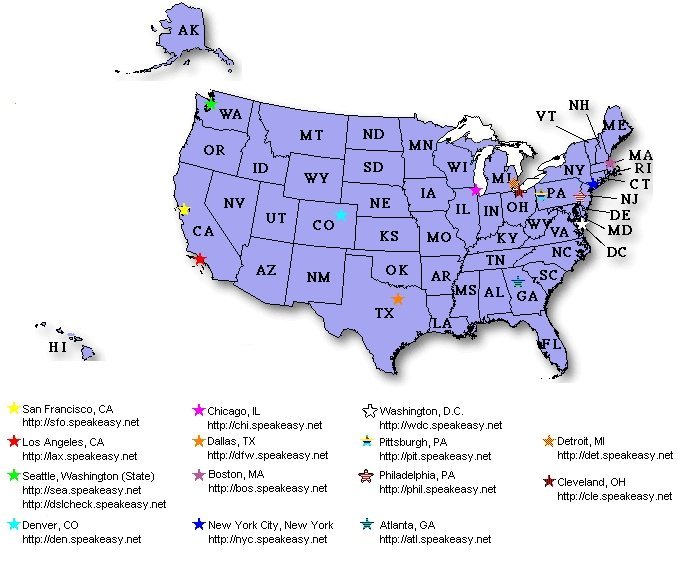 If you're unsure what speed test is closest to you, look at the map of Speakeasy.net speed tests. --
Map courtesy of RedXII1234Is there another way to check my speeds?Another option for testing your throughput is to download a large file from a fast server, such as one of these from OOL FTP 16meg or 64meg, for download speed tests. Then, upload that file to the webspace provided by your ISP or free server such as Yahoo to test your upload speed. When it's about 40% done, take note of the KB/s and cancel the download. Multiply the KB/s you got by 8.192 to determine your speed in kbps. Example: 56.2KB/s * 8.192 = 460kbps. To measure your download and upload speed, you may use a third-party throughput meter. Here are a couple popular free meters: NetStat LiveNetMeterInternational speed testsA big list of international speed tests can be found at TestMySpeed.com, but they are not like the Speakeasy java tests. They might show different results because of the distance and/or type of content being used to test. How does the upstream affect the downstream?If the upstream is saturated by uploading (e.g., sending a large PowerPoint file to the boss, or running a Napster or other public service), the downstream will drop to about the same speed. This is due to a weakness in the basic TCP Internet protocol, not Cable or DSL per se, and not the service provider.
A symmetrical connection (where the downstream and upstream are the same speed) is ideal for business use. If one person on the network on an asymmetrical connection uploads a large file, then everyone will slow down.
Will a 10Mbps or 100Mbps NIC help my speeds?Simply put, no.
A 10Mbps or a 100Mbps NIC (Network Interface Card) will not make a noticeable difference in your speeds, because this is the NIC's speed and not the speed of your Internet connection.
However, if your line is faster than 10Mbps (very rare), then you will need a 100Mbps NIC.
My speeds suddenly dropped -- can I tweak it?Yes, but it may not be necessary (and may not make a difference). Your "tweakable" TCP settings will not, in most cases, change unless you change them yourself with DRTCP or registry editing. Therefore, if you experience a sudden, large decrease in speed, chances are it is not a TCP issue, and thus there is no need to tweak. Run a line quality test here first to make sure the problem is not due to a distant line problem, such as a bad router at one or more hops. Then post your line quality test in the DSLR Tools forum if you want help diagnosing the problem. If your line is clean and you still have speed problems, then try tweaking. Different NIC, speed dropped dramatically.Some people encounter a heavy speed drop after installing a new NIC, or just after updating the drivers of their NIC. The drop is probably caused by wrong duplex settings of your NIC that some lines will not work with correctly. To change it, read further.
Windows ME/9x: Right click "My computer" > "Properties" > "Device Manager" > Drop down the "Network Card" in the list, go to its properties, and then to advanced. Set it to "10mbit Half."
Windows XP/2k: "Start" > "Control Panel" > "System" > "Hardware" > "Device Manager" > Drop down the "Network Card" in the list, go to its properties, and then to advanced. Set it to "10mbit Half."
If this does not help, try "Auto" and experiment from there.
Windows 98SE: Seem to have slow speed?In most cases, people using Windows 98 Second Edition will get slow speeds and stalls due to a problem in the NDIS Drivers. "This problem can occur if the NDIS intermediate driver code is preempted by the operating system when it is not safe to do so. As a result, a 'race' or 'deadlock' condition may occur, causing the operating system to hang."Microsoft KB ID: Q243199 Click here for Info and Download.How does RFI/EMI affect my speeds?Any device or system that generates an electromagnetic field in the radio frequency spectrum has the potential to disrupt the operation of electronic components, devices and systems in its vicinity. This phenomenon is known as ElectroMagnetic Interference (EMI), also known as Radio Frequency Interference (RFI). It may frequently cause packet loss because of the abnormal operation of your modem and other devices.
The internal circuits of personal computers generate RF fields. Also, cathode ray tube (CRT) displays generate EM energy over a wide band of frequencies, monitors in other words. These emissions can interfere with the performance of sensitive devices (such as your modem) nearby. If you have a sensitive device of any kind and use it at the same time as you operate your personal computer, you will probably hear RF noise in the receiver that originates in the PC system.
Why are peer-to-peer (file sharing) downloads slower?If you use a file sharing service such as WinMX, Morpheus, Kazaa, etc, then the rate at which you download will depend on the connection of the other person, more specifically, their upload speed.
If you were to download off of someone with a 256kbps upload, then they can send you files at 32KB/s, at most, if you are the only person downloading -- even if you are using a T1. If multiple people are downloading off of that person, the speed divides so everyone can get an equal share. Thus, it slows down more.
Why do downloads start FAST, then slow down?Actually, they're not really slowing down. After you click on the download button, the download begins while you're typing in the file name. If you take a while to do that, a considerable amount of data will be saved before the download speeds start registering. That's why it seems to be zipping along at first. But, after the buffer has caught up, it will then start showing your true download speed. Speed, too, will fluctuate as the servers that you're downloading from get busy, and your speeds will go up a little, then down a little. Don't forget, it's important to make sure your computer's optimized for speed. Be sure to check out DSLR/BBR Tweak Tools for tools to help you tweak your speeds. Also, be sure to check out the Tweaks forum for more useful information! --
originally submitted by Santa FeNIC drivers. Update yours for a possible boost.Yup. Even if you have a newish machine, your drivers may be a year or more old. New technologies lead to better drivers, which can pep things up a bit.
Two ways to do this.
1. Go to your NICs/dial-up adapters manufacturer and get updated drivers there.
2. Right click on My Computer, and then choose Properties/Device Manager. Click on the "+" sign next to Network Adapters. Double click on the adapter you use to connect with, then choose Driver/Update Driver/Next. Choose "Search for a better driver." Then, only enter a check for "Microsoft Windows Updates." Click Next. Follow the directions from there (easy). If new drivers are found, you will be informed. If not, there's nothing lost.
NT/2000/XP: How do I throttle my bandwidth?You can use a program called Shinra/Nimbus described in this thread. This program only works on Windows NT, 2000 and XP Home/Pro. If run on another OS, it may simply refuse to work. How does distance affect xDSL availability and speeds?Your distance from the Remote DSLAM or CO can affect your speed or ability to even get DSL. Below is a chart that illustrates what affects various distances might have. Distance
In Feet | Comment |
|---|
| less than 5000 | You will have little trouble getting all speeds of DSL. | | 5000-10600 | You may have trouble getting the highest advertised speeds. | | 10600-15000 | The danger zone for DSL from national CLECs like Covad. Advertised speeds are pinned back steadily until they reach 192k for 15,000 feet. If your line is longer than around 15000 feet, they may not accept an order. | | 15000-18000 | In this range, Telco ADSL is normally still available, although it may be restricted to 300-500k speeds. | | 18000-22000 | Telco ADSL is not available. Although, in at least a few areas, RADSL may be a product you can get. RADSL is speed-variable.
Some smaller DSL specialist CLECs may have solutions for you. | | 22000-28000 | By using less commonly used DSL equipment it is still possible to use lines of this length. | | 18000-28000 | IDSL is an alternative or possibly the only alternative. IDSL is 144k/sec, about four to six times modem speed. | | 28000-38000 | IDSL is the only alternative. |
Thanks to KeysCapt for the chart.Where are the Speakeasy Speed Test Sites?7. Tweaks TesterHow to read the Tweaks Tester results.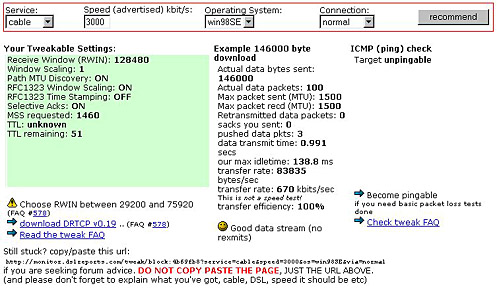 ______________________________ The Window surrounded in red will appear before the test is completed. You must fill it in correctly for valid results.Using the drop-down menus: 1. Enter the type of service that you have, in this case, Cable. 2. Enter the advertised speed from your ISP, which, in this case, is 3000kbps. If you have cable, you may have to pry this answer out of them. 3. The operating system that you use, in this case, Windows 98SE. 4. The connection type that you have, in this case, Normal. If you use PPPoE, enter which one. ~~~~~~~~~~~~~~~~~~~ The following are the only settings/readings to be concerned with: "Receive Window" is the RWIN that your machine is actually reporting, regardless of what may be entered into your registry and DRTCP. Suggestions for this setting are given at the bottom of the test. Note that the above test is recommending a lower RWIN setting. "Path MTU Discovery" should be ON for most every connection, or upload MTU (see "Max packet recd") will be compromised. "Windows Scaling" is only needed when RWIN is greater than 65535. Should read "OFF" if lower than 65536. "Time Stamping" may be used on lines that experience packet loss. "Selective Acks" should be on. "MSS" is the "Maximum Segment Size." In practice, that means the amount of space used in each packet to hold your "data." It is the size of the "Data Field" of your packets, generally both downloaded and uploaded packets. This should always be 40 less than your MTU (Max packet recd on tester). "TTL" is time to live, and it should be 64 or 128 ( not a speed setting!). If you use a router/firewall, the number shown may be inaccurate. ~~~~~~~~~~~~~~~~~~~ "Max packet sent" (MTU) is download and the size packet that DSLReports sent you during the test. "Max packet recd" (MTU) is upload and the size that DSLReports received from you. If this is less than Max packet sent, your Path MTU Discovery may be OFF (seeing 576 is common if it's OFF). For PPPoE, MTU should be between 1454 and 1492. For non-PPPoE, and PPPoA, it should be 1500. "Transfer efficiency" refers to how well the packets sent to you were received. 90-100% is considered acceptable. This will vary throughout the day and night as traffic varies on the Net. ~~~~~~~~~~~~~~~~~~~ "ICMP (ping) check" is to show basic ping packet loss. Make yourself pingable before running the test. This can show line issues not otherwise seen. Note that in this test the user was not pingable. Also note that ping is non-adjustable. ~~~~~~~~~~~~~~~~~~~ Follow FAQs suggested (if any) to fix issues noted. As the test states at the bottom, "Still stuck? Copy/paste this URL." Please post that URL to the Tweaks Forum if you require assistance. You must also answer the other 11 questions found here. Tweak Tester reports retransmissions: Why?The purpose of TCP is to cope with links that may exhibit packet loss, or may even allow packets to arrive out of order or in duplicate.
The tweak tester can notice packet retransmissions during the test file transfer. This is not a disaster. The Internet has weather, and the weather is not always sunny. When there are storms (congestion or other problems en-route), packets can get dropped and must be sent again.
Persistent and high numbers of retransmissions may also be due to a high RWIN (receive window) on your end, which is why they are reported.
Retransmissions of data reduce throughput, reducing the speed at which you receive data. Particularly lossy links (perhaps representing ISP congestion, or even problems on your own line), wreak havoc on download speeds, even reducing them to a crawl.
A Line Quality Test may reveal more about the source of your packet loss problems.
Pingable: Why do some tests want me to be?Finding the ideal RWIN is one very good reason for becoming pingable, as RWIN is found using a calculation of latency (ping) and speed.
The Line Quality test needs you to be pingable as well.
Once testing is completed, simply make yourself non-pingable again.
1 or 2+ second stall detected.This problem is quite common and is not a big issue. Congestion on the Net is the cause, which will fluctuate throughout the day/night.
If it is a consistent finding, run a Line Quality Test and look for slow, bogged-down servers (red & yellow warnings).
The most important thing is speed. If your speeds are fine, then don't be concerned with this.
Tweak Tester does not work!There are several reasons why the tweak tester might not work for you:
• It is offline.
• It was too busy at the time you requested the test.
• You've tested more than 5 times in a short period.
• Your Java setup is broken.
• Your MTU is too high.
The last reason needs some further explanation: the tweak applet, if it loads ok, starts by sending some data upstream to us. If all this data is not received, then the tweak test results may not even get reported back to you.
This is probably an MTU problem. Some hardware firewalls require that you lower your MTU slightly. Try the test without the firewall to see if it works. Or, just try to lower your MTU using DrTCP, described elsewhere in this FAQ.
Starband Satellite: Adjustments won't take!Sorry. Starband locks their settings to those below. There is no "fix" for this as of yet.
Receive Window (RWIN): 11344
Window Scaling: off
Path MTU Discovery: OFF
RFC1323 Window Scaling: OFF
RFC1323 Time Stamping: OFF
Selective Acks: OFF
TTL: 64
MSS requested: 1418
Max packet sent (MTU): 1458
Max packet recd (MTU): 882
Which ports to forward for a hardware firewall.If you have a hardware firewall and the Tweaks Tester won't run for you, forward these ports:
1. First step communicates on 8086
2. Second step uses 8085
3. Third is icmp:8 to icmp:0
Overall, you need 80, 8086 and 8085 -- icmp is optional.
Time Stamping: How do I turn it on (or off)?The need for Time Stamping seems to be in question, at least with RWIN under 65535. If you have a line where latency varies a lot, or a "long fat pipe" (for example, pure satellite connection), then Time Stamping should be beneficial, so experiment with it. Time Stamping defaults to off (No). To set Time Stamping, download DRTCP021.exe. from this page. Set Time Stamping to Yes (or No) using the drop down menu. Tab to "Apply" and click it. Then reboot and retest. Time Stamping and DirecPCExtensive testing has shown that enabling time stamping when using a DirecPC-based connection does slightly increase download speed (about 5% on average). However, it also causes significant problems with certain websites. In particular, interactive sites and secure sites often will not load completely or will not load at all with time stamping enabled. In addition, enabling time stamping with these systems will cause large email attachments to fail to download. For these reasons, it is recommended that time stamping not be used on DirecPC, Earthlink, AOL+ and Pegasus Express satellite broadband systems.
Why do I get Upload packet less then your MTU warning?(Windows) This issue is most often caused by Path MTU Discovery being turned Off, which tends to decrease your upload speeds, sometimes considerably. Download DrTCP021.exe (for Windows OS's only) from this page to your desktop. Open it and set Path MTU Discovery to either "Default" or "Yes" (same thing). Click Save, then reboot and retest. (Mac) This is a false issue on the Mac; the TweakTester deducts 12 bytes (the timestamp segment) from the MTU. The actual MTU is whatever is shown plus 12. 8. Using the Tweaks ForumWhat information should I post with my question?We must have the answers to these 11 questions before we can help you. Simply put N/A for any that do not apply to you. There are no shortcuts to being helped, as we need this info. 1. A Tweaks test from this page. Simply post the test's URL. Please make yourself pingable.2. The closest of 2 speed tests from the Speakeasy Test Sites page. Please note the URLs of both result pages for us. 3. A Line Quality test from here. Please copy and post the URL in the red box! This could take a while, so you might run this first. If it's too backed up, do it later, if requested. 4. What type of Internet connection you have (DSL, Cable, Wireless, or Satellite), who your ISP (Internet service provider) is and the make, model and type of your modem. 5. If DSL, do you use PPPoE connection software? (Do you have to connect to the Internet?) 6. If PPPoE, which one -- WinPoet, Enternet, RASPPPoE, WinXP Native, etc? 7. Which operating system you use -- Windows 98/98SE/ME/2K/XP, etc. 8. What your advertised speeds are (ask your ISP). 9. If your PC is on a network and/or using ICS (Internet Connection Sharing) or VPN. 10. If you use a NAT router (Linksys, Netgear, etc.) for sharing your connection, and if so, the brand and model of your router. 11. How far you are (if using DSL) from the CO (Central Office). Keep in mind that further than 10,000 feet can significantly degrade speeds. Click here to find your distance, or simply ask your ISP.
Satellite Users Note: The tests listed here will likely not return accurate results and will probably be a waste of time for most satellite broadband users. If you would like more information about tweaking your connection, consider posting in the Satellite Forum. How do I post the top 3 results?To copy and paste results of a: Tweaks test: Go to tweak test. Run the tweaks test, and click Results when it finishes successfully. Next, fill in what type of service you have, your advertised speeds, operating system and type of protocol you use. Cable and ethernet is normal. Click Recommend. Copy the URL to the test, not the test itself! Post that as #1. Speed test: Check Verbose, then click Start. When the test finishes, click Graph and copy the URL in your browser's address bar. Post that as #2. Line quality test: Go to line test. Fill in your IP to join the queue. If you have a router, then make sure you are using the router's IP. When the test finishes, view it and copy and paste the URL in the red box to hide your IP address. Post it as #3. Can I help answer questions?Please do so only if you are sure of your advice. There are many variables in tweaking different connections, and this eludes most would-be helpers at first. In other words, what worked for you may indeed not work for someone else -- and may even make matters worse.
Should I add my question to someone else's thread?Please do not, as this makes it rather confusing for those who are helping. Start a new thread with your question(s). Also, please use only one thread for all of your questions regarding your "problem."
Please keep all of your questions in 1 thread (place).This is very important! We will ask you for information that we need in order to gain insight into any problem you may have. If you then start another thread, we will not have immediate access to that information. What will happen is helpers will ask you all the same questions again, wasting valuable time and forum space.
It is difficult at best to go searching for information that you posted yesterday (or whenever) in another thread. So much so, in fact, that we may not have the time (or desire) to do it. Therefore, you will not receive the help that you came for, as the Tweaks forum is very popular and there are many people for us to assist.
How do I start my own thread (posting area)?Simply click on the words "New Topic" near the upper right hand corner of your screen when viewing the main page of the forums.
Please start only one thread for all of your questions.
Are Moderators/helpers paid?No. The only compensation that anyone receives is the satisfaction of helping others. All of us started the same way: asking for help. We "work" here on a strictly volunteer basis.
So before you get down on one of the regular helpers, or RedXII1234 (Forum Host), for whatever reason, think about it! The advice/service we offer is free, personal and amongst the best you'll find, anywhere.
How can I find the thread I posted in?Simply click on your name/avatar. There you will have a list of your posts for at least the past 14 days.
If you need help, read this!Please click on the big red *here* at the top of the Tweaks Forum. It is there for you and is truly the only way that we can help you.
See this line:
Before you ask for help, click right *here*!
Links recommended for the Tweaks Forum.9. WindowsProxy server: How do I bypass/use it on my line?For Internet Explorer, go to Tools/Internet Options-Connections tab, LAN Settings; un-check anything there. Close your browser, then fire it up again. It may take longer the first time or so, but it should be smooth sailing from there.
~~~~~~~~~~~~~~~~~~~~~~~~
For Netscape, go to Edit/Preferences/Category; double-click on Advanced/Proxies. Select "Direct connection to Internet," then click OK.
~~~~~~~~~~~~~~~~~~~~~~~~
For @Home users, you may need to do this.
Go to Start/Run, then type:
regsvr32 /u ahiehelp.dll
Or
regsvr32 -u ahiehelp.dll
Click OK.
Also, make sure that no @Home software is on your PC.
~~~~~~~~~~~~~~~~
To use the Proxy server (@Home customers), do this:
Enter a check mark for "Use automatic configuration script." Then type in "proxy:8080/" (no quotes).
Used a Speed Patch? Want to see what it did?Well, some of what it did anyway.
NetTrans/000n folder education, 101.
This can get rid of all the "shotgun," bogus entries that these patches give you. In other words, goo. Having extra NetTrans folders is pointless, and it may even have a negative effect somewhere.
If you have a sniffer program, that adds several, and analyzer programs add some. VPN gives you at least one (depends on bindings). Then you get one .../000n key for each Protocol-Adapter pair that you have. TCP/IP > Dial-up is one. TCP/IP > every NIC you have is one each. NetBEUI, IPX/SPX or any other Protocol will add one for EACH Adapter to which they are bound. Get the idea? They come from a lot of places.
Well, let us see exactly what they are on your system. This analysis is exactly the same one I use to figure out which entries are not needed (i.e., which extraneous ones were added by SpeedGuide, etc).
~~~~~~~~~~~~~~~~~
First off, how many entries do you have in the Dr.TCP Adapter drop-down list? Temporarily change each one of those to their own unique number -- 111, 222, 333 or whatever you like. Apply and close Dr.TCP. You do not have to reboot yet!
Open regedit (go to Start/Run, and type in "regedit" (no quotes), and by looking for your unique MaxMTU numbers, find out which 000n key belongs to which Adapter -- write this down. Some 000n keys will obviously NOT be for TCP/IP. If an entry *is* for TCP/IP, you will find at least these two entries in the main .../000n key:
DriverDesc. "TCP/IP"
MaxMTU "1500"
While you are in the registry, you will want to modify the "Help Text" line in *each* of these keys:
HKEY_LOCAL_MACHINE\System\CurrentControlSet\Services
\Class\NetTrans\00nn\Ndi [where nn is a number]
For example, the Help Text line for a TCP key looks like this:
"TCP/IP is the protocol you use to connect to the Internet and wide-area networks."
If you can't tell what adapter a certain 000n entry belongs to, modify the line to look like this:
"(NetTrans 0001) TCP/IP is the protocol you use to connect to the Internet and wide-area networks."
If you can tell by the unique Dr.TCP number that a given 000n entry belongs to a specific adapter, modify the line to instead look something like this:
"(NetTrans 0002 : Linksys Etherfast NIC) TCP/IP is the protocol you use to connect to the Internet and wide-area networks."
Regardless of what the key is for (TCP/IP, NetBEUI, etc), modify the Help Text line in some unique way to clearly identify the .../000n key to which it belongs.
Close regedit, reset the MaxMTU settings in Dr.TCP to their correct numbers and reboot.
Now go to Control Panel | Network. Find the Protocol-Adapter pairs you have listed. Select each one sequentially and note the box at the bottom that says "Description." Magically, you will be able to tell exactly which NetTrans key belongs to which Protocol-Adapter pair.
This should clearly identify which NetTrans keys are being used and what is using each of them. Additionally, by their absence, it tells you which ones are "dead weight." If you desire, backup this section of the registry (Export>) and jettison the dead weight. Voila!
From R2 a while back.
9.1 Windows 9x/MEVtcp.386 update for Win 95/98/98SE: Do I need it?This update fixes three problems: 1) Unnecessary packet re-transmissions (i.e send/upload) in extremely high-delay satellite links. 2) Makes it possible to enable large window support (Scaling) so that TCP Receive Window (RWIN) can be set higher than 65535. 3) Makes it possible to activate Time Stamping. If you are not on a satellite link or not one of the rare users who need RWIN > 65535, then you probably don't need this, but it does not hurt to apply it. Go here if you use Win95, and here if you use Win98/98se, for the update. Why the System.ini (IRQn=4096) trick doesn't work.The claim is that the tweak (IRQn=4096) improves network performance by allocating 4 megabytes of memory as a buffer for the IRQ (n) used by your network adapter. However: - The setting has no effect on actual memory allocation.
- The setting does not actually affect network performance in carefully controlled tests. (Anecdotal reports are mixed and unreliable due to Internet and system variables, particularly the effects of caching.)
- There is no apparent evidence that there even is any such setting in Microsoft documentation.
- Windows does not allocate buffer memory for IRQs. (Buffers are the responsibility of device drivers, which allocate them by device, not by IRQ. On the PCI bus, a single IRQ can be shared by multiple devices.)
While it doesn't help, the good news is that (like TTL) this setting doesn't hurt (assuming you don't screw up your SYSTEM.INI file). Windows just ignores settings that it doesn't recognize. reference9.2 Windows 2000/XPHow Do I Create a PPP over Ethernet (PPPoE) Connection for WinXP?9.3 Windows Vista/7Information about tweaking Windows VistaChanging MTUYou need to run and elevated command prompt. Click Start > All Programs > Accessories, right-click Command Prompt and Run as administrator, Allow it to have administrator privileges, otherwise it won't work.
Then type/copy & paste the following command:
netsh interface ipv4 set subinterface "Local Area Connection" mtu=xxxx store=persistent
Where xxxx = the MTU that you want. Rebooting isn't required. "Local Area Connection" is a common name for the interface if you use a NIC for connectivity. A wireless NIC may be called "Wireless Network Connection". If unsure, the network status icon by the clock will tell you.
If you have a router, ensure that the MTU is set to the MTU chosen here (refer to your router's manual).
10. MacintoshHow do I tweak in OS X?First of all, if you've run the Tweak Tester, it likely advised you to turn on "selective ACKs." Unfortunately, selective ACKs are not supported by OS X. A brief note on MTU values: the default MTU under OS X is 1500, and this will work fine for most users. Some ISP/router combinations require a user to change the MTU to a different value, usually 1450. In these cases, the change to the MTU isn't made to improve performance; it ensures functionality. Usually, if not always, the DSLR Tweak Tester will report the MTU of an OS X machine as 1488 -- this is a misreading on the part of the Tweak Tester caused by OS X having timestamps enabled (see below). To change timestamps to "off," and eliminate the "1488" (the erroneous MTU of 1488 reported by the Broadband Reports Tweak Tester), this value "net.inet.tcp.rfc1323" should be set to zero. To restore timestamps, the value should be set to 1 (note: this is the system default). There is now a GUI utility called RMAC that will modify the MTU value, timestamps, TCP receive window, etc. The documentation is in Japanese, but its use is quite self-explanatory. If you want your modifications to survive a reboot, make sure to have RMAC install a Startup Item. A note on how RMAC works: when you launch it, it presents you with a number of networking parameters you can change (e.g., MTU, RWIN, timestamps, etc). When you change the values and click "apply," RMAC changes the settings just as if you were typing the commands (e.g., sudo ifconfig en0 mtu 1450) at the command line in Terminal. Thus, you can play with these various settings to optimize your connection. However, when you restart your machine these settings will be lost, as OS X will load the default network parameters at boot time. For this reason, RMAC gives you the option to "Install RMAC to Startup Item" -- do not confuse a Startup Item with a login item, which is an application that is automatically launched at login. What this does is create a script which is placed in "/Library/StartupItems," a directory which is created if it doesn't already exist. This script overwrites the OS X networking defaults at boot time with current modifications you have made to the networking parameters via RMAC. This procedure is very similar to the one described in the Apple KB article, except the process is automatic -- RMAC does all the work. If you wish to add commands that aren't included in the RMAC GUI, such as ethernet speed or duplex, you can add them yourself by clicking the "Edit Script File" button. After RMAC has installed the Startup Item there is no need to run the application again, unless you want to make further changes. |

